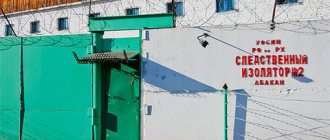What are the differences and similarities between an act and a resolution?
A lot of people confuse the indictment and the indictment; this is not at all strange, because the documents are similar in purpose, but there are still differences in the content of each of them.
Unlike the conclusion, the act has a dual purpose. The indictment not only represents the end of the inquiry procedure, but also gives the subject of criminal proceedings the procedural status of the accused. According to Art. 225 of the Code of Criminal Procedure of the Russian Federation, the act contains a conclusion about the need to forward the criminal case to the prosecutor for its subsequent transfer to court. The indictment contains only information about the results of the pre-trial investigation.
An indictment is made by the investigator if the investigative actions are completed and the collected amount of evidence is sufficient for a reasonable conclusion that a crime has been committed by a specific person. The document is issued if a shortened form of inquiry takes place, for example, if the criminal confessed to everything and cooperated with the investigation. The indictment lists the circumstances that take place in a particular proceeding and prove guilt, according to Art. 225 Code of Criminal Procedure of the Russian Federation.
In their content and form, the indictment and the indictment practically repeat each other. The resolution, according to Article 225 of the Code of Criminal Procedure of the Russian Federation, must be drawn up no later than 10 days from the date of the decision to conduct an inquiry in an abbreviated form.
After signing by the investigator and the head of the investigative body, the conclusion and act are handed over to the parties to the process for review. Both parties have the right to submit the following requests:
- on recognizing the evidence specified in the indictment or act as inadmissible;
- on carrying out additional investigative and other actions to supplement the evidence base, which is not sufficient for an objective conclusion about the involvement of a particular subject in a crime;
- on the performance of additional investigative actions aimed at verifying the reliability of evidence that raises doubts;
- on restatement of the resolution if it does not meet the requirements of Part 1 of Art. 2267 Code of Criminal Procedure.
If, before the expiration of the period specified for familiarization with the resolution or act, no petition is filed, the document is sent to the prosecutor and the judge. The indictment and the act must be accompanied by a certificate indicating information about the place of residence or location of the witnesses who must testify in court.
There must be a certificate describing the preventive measure that was chosen for the suspected person, the period of inquiry in an abbreviated form and information about the presence of dependents of the arrested offender. If there are dependents, then the measures that have been taken to preserve their legal rights are described.
Together with the indictment or resolution drawn up in accordance with the instructions of Art. 225 of the Code of Criminal Procedure of the Russian Federation, all materials of the case are transferred to the prosecutor. It is important to note that the state prosecutor - prosecutor has the right, by his decision, to exclude certain points from the charge, to reclassify the criminal act, or to order the re-drafting of the resolution and act if there are inaccuracies. If the prosecutor approves the charge, the trial begins. After approval of the resolution or act by the prosecutor, petitions and statements related to the criminal case must be submitted to the judge, not the prosecutor.
Indictment
Lawyer Antonov A.P.
One of the types of accused is defined in clause 3, part 1, art. 47 Code of Criminal Procedure of the Russian Federation. This is the person against whom “an indictment has been drawn up.” The question arises, why does the legislator write about issuing a resolution to charge him as an accused and an indictment, but about drawing up an indictment? Is there a fundamental difference in the aspect under consideration between “making” and “composing”?
Comparing the meaning of these two words, it is easy to notice that a person becomes accused when an indictment is issued, just as in the case of others listed in Part 1 of Art. 47 of the Code of Criminal Procedure of the Russian Federation with procedural documents. The indictment will be drawn up even before it is signed by the interrogating officer, and even more so before it is approved by the head of the inquiry body. No wonder in Part 1 of Art. 226.7 of the Code of Criminal Procedure of the Russian Federation first states when this resolution should be drawn up. And only in the next part of the same article - that it must be signed and approved. And it is unlikely that an undrafted resolution can be signed, much less approved, by the head of the inquiry agency. Meanwhile, until the document drawn up is signed, until the indictment is approved, it cannot be considered issued and in the criminal process in the situation under consideration until the specified moment (signing and approval) there will be no accused.
In other words, the term “drawn up”, used in clause 3, part 1, art. 47 of the Code of Criminal Procedure of the Russian Federation, despite its etymology, should be interpreted in the same way as it was customary to understand the meaning of the term “issued” before. Once again, we draw the attention of the law enforcement officer - drawing up an indictment is not enough to ensure that in the event of an inquiry in an abbreviated form, such a subject as the accused will appear in the criminal process. The status of an accused in the required situation for a person against whom an indictment has been drawn up will appear only after the indictment has been signed by the investigator and approved by the head of the inquiry agency.
This is why we believe that the use of the term “drafting” in clause 3, part 1, art. 47 of the Code of Criminal Procedure of the Russian Federation is flawed. For the same reasons, it seems not entirely consistent to use the term “compiled” (“compilation”) in parts 3 and 4 of Art. 226.7 Code of Criminal Procedure of the Russian Federation. There, the drafting rather means complete execution, which includes not only the drafting itself, but also the signing of the indictment by the interrogating officer, as well as its approval by the head of the investigating agency.
No later than 10 days from the date of the decision to conduct an inquiry in an abbreviated form, the indictment must not only be drawn up, but also signed by the inquiry officer and approved by the head of the inquiry body. The accused and his defense attorney must be familiarized with the indictment and the materials of the criminal case no later than 3 days, not from the day the indictment was drawn up and not even from the day it was signed by the interrogating officer, but from the day it was approved by the head of the inquiry agency.
Our statement may well be considered controversial, according to which an indictment cannot be considered issued (“drawn up,” finally formalized) until it is approved by the head of the inquiry agency. Meanwhile, it is fully confirmed by the very structure of Art. 226.7 Code of Criminal Procedure of the Russian Federation.
Article 226.7 of the Code of Criminal Procedure of the Russian Federation is structured in such a way that first (Part 2) it talks about the approval of the indictment by the head of the inquiry body, and only after that - about the timing of drawing up the indictment (Part 3), the period during which the accused and his defense attorney must be familiar with the indictment and materials of the criminal case, etc.
One more argument in defense of our position. Until the indictment (indictment) is approved, it may undergo some changes and, accordingly, it cannot previously be considered finalized (“drawn up”, “issued”), as a result of which it cannot be presented in this form for review the accused, his defense attorney, etc.
The law enshrines the right of the head of the inquiry body to approve the indictment (indictment). Nothing is said about what he has the right to do if, in his opinion, an amendment should be made to the indictment (indictment) that will improve its structure, content, wording of individual elements, etc. Meanwhile, the mere fact that the head of the investigative body has the right to approve the required procedural document, in itself gives him the opportunity not to approve it. Having this tool in his arsenal, of course, the head of the inquiry agency is able to influence the content of the indictment (indictment), which will be sent to the prosecutor. That is why, until he puts his signature on it (approves it), the indictment (indictment) cannot be considered “drawn up” (“issued”) in the form in which it will be sent to the prosecutor. And the accused, his defense attorney (if there is a petition, the victim, his representative) have the right to familiarize themselves with the text of the indictment (indictment) in the wording in which the prosecutor sees it. Otherwise, the very meaning of their familiarization with the document in question is lost. Actually, this is why we believe that a person becomes accused after the indictment that is approved by the head of the inquiry agency is drawn up. Until this allegation took place, such an indictment (drafted indictment) simply does not exist in criminal proceedings.
And now a few words about the structure of the indictment. The latter must comply with the requirements of paragraphs 1 - 8 of Part 1 of Art. 225, parts 1 and 2 art. 226.7 Code of Criminal Procedure of the Russian Federation.
Thus, the procedural document in question includes:
1) the resolution of the supervising prosecutor approving the indictment, indicating the name of the prosecutor's office, class rank, surname, initials of the prosecutor and the date when the indictment was approved by him;
2) a resolution of the head of the inquiry body approving the indictment, indicating the name of the inquiry body, rank, surname, initials of this head, as well as the day, month, year when the indictment was approved by him;
3) the name of the document indicating who is accused and under what points, parts and articles of the Criminal Code of the Russian Federation the indictment was drawn up;
4) information about the identity of each person charged as an accused:
a) last name, first name, patronymic;
b) date of birth;
c) place of birth;
d) place of residence and (or) registration (mobile phone number, if any);
e) citizenship;
f) education;
g) marital status, family composition;
h) place of work or study (office telephone number, if available);
i) attitude to military duty and where the person is registered with the military;
j) presence of a criminal record (when and by what court he was convicted, under what paragraph, part, article of the Criminal Code of the Russian Federation, type and amount of punishment, when he was released);
k) details of the passport or other identification document of the person in respect of whom the indictment is being drawn up;
l) if necessary, other information about the identity of the accused. These may be: nationality (established in order to determine the need to invite an interpreter), the presence of family relations with any of the participants in criminal proceedings who have an independent interest in the criminal case, etc.;
5) the substance of the charge, the place and time of the crime, its methods, motives, goals, consequences and other circumstances relevant to the given criminal case (plot);
6) the wording of the charge, indicating the paragraph, part, article of the Criminal Code of the Russian Federation, providing for liability for this crime;
7) a list of evidence confirming the accusation and a brief summary of their content indicating the volume number, sheets of the criminal case;
9) circumstances mitigating and aggravating punishment (a brief summary of each circumstance), indicating the volume number, sheets of the criminal case;
10) information about the victim, the nature and extent of the harm caused to him by the crime, indicating the volume number, sheets of the criminal case;
11) information about the civil plaintiff indicating the volume number, sheets of the criminal case;
12) information about the civil defendant indicating the volume number, sheets of the criminal case;
13) locality, day, month, year of drawing up the indictment, number of the criminal case, information about the prosecutor’s office to which the criminal case with the indictment was sent;
14) position, rank, surname, initials of the investigator who drew up the indictment.
It is easy to see that all the general requirements for an indictment are similar to those for an indictment.
Sincerely, lawyer Anatoly Antonov, managing partner of the law firm Antonov and Partners.
Still have questions for your lawyer?
Ask them right now here, or call us by phone in Moscow +7 (499) 288-34-32 or in Samara +7 (846) 212-99-71 (24 hours a day), or come to our office for a consultation (by pre-registration)!
What it is
The indictment of the Criminal Procedure Code in the Russian Federation is a procedural act that contains conclusions about the investigative work done and forms the outcome of the investigation.
The issuance of such a paper will mean the completion of the preliminary investigation stage and the transfer of the case to the prosecutor for prosecution.
In criminal proceedings, such a document acts as an appeal from law enforcement officers to the court, so that the case is resolved through legal proceedings and a sentence is passed. Such an act can only come from persons carrying out investigative measures.
Art. 220 in the Code of Criminal Procedure of the Russian Federation, as well as the commentary to it, establish the requirements, tasks and goals of such an act.
In addition, such a paper must always meet a number of requirements for its content and order of preparation:
- the events of the crime should be specifically indicated and the events should be individualized in relation to the accused;
- if there are several elements, for example, murder and theft, all events should be reflected here in detail, but with specification of each of them;
- the sample of any accusation presupposes the absence of information that violates the interests of the criminal, exaggerating the degree of his guilt;
- evidence in the case should not be presented, as this may cause pressure on the prosecutor and the court before they conduct a detailed and independent study of the case materials;
- all events must be reflected either in chronological order or systematically; a combination of these methods of displaying information for several criminal episodes is allowed;
- accusing a person when adopting the specified act should be with the same wording as when drawing up a resolution to bring him in as a suspect;
- the document must contain references to the case materials, despite the fact that there should not be a direct reference to evidence;
- It is always necessary to draw up an annex, indicate the persons involved in the case, a list of evidence, but without explaining it, and so on.
The document, signed exclusively by the investigator, is ultimately transferred to higher authorities. The document must be approved by the leadership of the investigative agency, as well as by the prosecutor.
Accordingly, based on the essence of the prosecution’s conclusion, it performs several functions at once, since it is an integral part of solving the crime. Firstly, the indictment document forms the result of the investigator’s work, draws conclusions that must subsequently be verified and applied as a basis when making a decision by the court.
Secondly, the presence of the procedural act in question guarantees legality. Changing the information is not allowed after it has been signed and approved at the discretion of the participants in the investigation, which ensures the protection of the interests of the perpetrators.
In addition, control by the prosecutor’s office also makes it possible to bring the results of the investigators’ work to legality and justice.
And thirdly, any violations associated with the preparation and adoption of the indictment exclude the possibility of further transfer of the case to higher authorities. Completing all stages of the investigation guarantees its legality and will not allow the perpetrator to escape punishment due to procedural shortcomings in the case.
Termination of a criminal case: grounds and procedural order
Termination of a criminal case is a form of ending the preliminary investigation, in which the investigator completes the criminal proceedings by his decision without subsequently sending the case to court.
An investigation into a criminal case is terminated if, as a result, circumstances have been established that exclude the possibility or necessity of further proceedings in the case. Justified and timely termination of a criminal case protects an innocent person from being brought to criminal liability or excludes the application of criminal punishment to those persons who do not pose a great public danger due to the insignificance of the committed act and subsequent reconciliation with the victim, active repentance or other circumstances provided for by law.
The Criminal Procedure Law provides an exhaustive list of grounds for termination of a criminal case (Article 212 of the Criminal Procedure Code). The preliminary investigation is terminated:
- if there are circumstances that exclude proceedings in the case (Article 24, paragraphs 3–8, Part 1, Article 27 of the Criminal Procedure Code);
- the non-involvement of the suspect or accused in the commission of a crime has been established (clause 1, part 1, article 27 of the Criminal Procedure Code);
- there are circumstances that allow the investigator and inquiry officer, with the consent of the prosecutor, to release a person from criminal liability (Articles 25, 26, 28 of the Criminal Procedure Code).
Grounds for termination of the criminal case provided for in clauses 1, 2, part 1 of Art. 24 (absence of a crime and absence of corpus delicti in the act) and paragraph 1 of Part 1 of Art. 27 of the Criminal Procedure Code (non-involvement of the suspect or accused in the commission of a crime) are rehabilitative and mean a recognition of the person’s innocence of committing a crime. If the case is terminated on these grounds, the investigator or prosecutor takes the measures provided for by the Criminal Procedure Code to rehabilitate the person and compensate for the harm caused to him as a result of criminal prosecution (Part 2 of Article 212 of the Criminal Procedure Code).
The procedure for terminating a criminal case is established by Art. 213 of the Criminal Procedure Code. The case is terminated by order of the investigator, a copy of which is sent to the prosecutor. The resolution states:
- date and place of its preparation;
- position, surname and initials of the investigator;
- the circumstances that served as the reason and basis for initiating a criminal case;
- clause, part, article of the Criminal Code, providing for the crime on the basis of which a criminal case was initiated;
- the results of the preliminary investigation indicating information about the persons against whom criminal prosecution was carried out;
- the preventive measures used;
- clause, part, article of the Code of Criminal Procedure on the basis of which the criminal case is terminated;
- a decision to cancel the preventive measure, as well as the seizure of property, correspondence, temporary removal from office, control and recording of negotiations;
- decision on physical evidence;
- procedure for appealing this decision.
Termination of a criminal case due to the expiration of the statute of limitations for criminal prosecution; due to the absence of a court conclusion on the presence of signs of a crime or due to the lack of consent of the Federation Council, the State Duma, the Constitutional Court of the Russian Federation, the qualification board of judges to initiate a criminal case or involve as an accused a circle of persons established by law (clause 3.6 of Part. 1 Article 24 of the Criminal Procedure Code); in connection with the reconciliation of the parties; in connection with active repentance (Articles 25, 28 of the Criminal Procedure Code), as well as in connection with an act of amnesty or refusal of the Federation Council or State Duma to give consent to the deprivation of immunity of persons established by law (Clause 3, 6 Part 1 of Art. 27 of the Criminal Procedure Code) is allowed only with the consent of the accused.
The investigator hands or sends a copy of the decision to terminate the criminal case to the person against whom the criminal prosecution has been terminated, the victim, the civil plaintiff and the civil defendant. At the same time, the victim, the civil plaintiff, is explained the right to bring a claim in civil proceedings if the case is terminated on the grounds provided for in paragraphs 2–6 of Part 1 of Art. 24, art. 25, paragraph 2–6, part 1, art. 27, 28 of the Criminal Procedure Code.
In cases where there are several accused in a criminal case, and criminal prosecution is terminated only against one of them, the investigator, in accordance with Art. 27 of the Criminal Procedure Code makes a decision to terminate criminal prosecution against this accused.
Having recognized the investigator's decision to terminate a criminal case or criminal prosecution as illegal or unfounded, the prosecutor submits a reasoned resolution to forward the relevant materials to the head of the investigative body to resolve the issue of canceling the decision to terminate the criminal case. Having recognized the investigator's decision to terminate a criminal case or criminal prosecution as illegal or unfounded, the prosecutor cancels it and resumes the criminal proceedings. Having recognized the investigator's decision to terminate the criminal case or criminal prosecution as illegal or unfounded, the head of the investigative body cancels it and resumes the criminal proceedings.
If the court recognizes the investigator’s decision to terminate a criminal case or criminal prosecution as illegal or unfounded, then it makes an appropriate decision and sends it to the head of the investigative body for execution.
Resumption of proceedings on a previously terminated case may take place in accordance with the emergence of new or newly discovered circumstances, but only if the statute of limitations for bringing a person to criminal liability has not expired.
The decision to resume criminal proceedings is communicated to the accused, his defense attorney, the victim, his representative, the civil plaintiff, the civil defendant or their representatives, as well as the prosecutor.
What are the differences and similarities between an act and a resolution?
A lot of people confuse the indictment and the indictment; this is not at all strange, because the documents are similar in purpose, but there are still differences in the content of each of them.
Unlike the conclusion, the act has a dual purpose. The indictment not only represents the end of the inquiry procedure, but also gives the subject of criminal proceedings the procedural status of the accused. According to Art. 225 of the Code of Criminal Procedure of the Russian Federation, the act contains a conclusion about the need to forward the criminal case to the prosecutor for its subsequent transfer to court. The indictment contains only information about the results of the pre-trial investigation.
An indictment is made by the investigator if the investigative actions are completed and the collected amount of evidence is sufficient for a reasonable conclusion that a crime has been committed by a specific person. The document is issued if a shortened form of inquiry takes place, for example, if the criminal confessed to everything and cooperated with the investigation. The indictment lists the circumstances that take place in a particular proceeding and prove guilt, according to Art. 225 Code of Criminal Procedure of the Russian Federation.
In their content and form, the indictment and the indictment practically repeat each other. The resolution, according to Article 225 of the Code of Criminal Procedure of the Russian Federation, must be drawn up no later than 10 days from the date of the decision to conduct an inquiry in an abbreviated form.
Peculiarities of completing an inquiry by drawing up an indictment (indictment)
After the investigator recognizes that the necessary investigative actions have been carried out and the volume of evidence collected is sufficient for a reasonable conclusion that the suspect has committed a crime, he draws up an indictment or indictment resolution, if the inquiry was carried out in an abbreviated form. The indictment indicates the same circumstances as listed in paragraphs 1–8 of Part 1 of Art. 225 of the Code of Criminal Procedure of the Russian Federation for the indictment, as well as links to the sheets of the criminal case. An indictment and an indictment are procedural documents that conclude an investigation and formulate charges based on evidence incriminating the accused of committing a crime [1]. They are not only final decisions, but also procedural documents on the basis of which the suspect acquires the procedural status of the accused, in contrast to the indictment of the preliminary investigation.
It should be recalled that according to Part 1 of Art. 47 of the Code of Criminal Procedure of the Russian Federation, a person receives the legal status of an accused from the moment a decision is made to charge him as an accused or an indictment is issued. From this moment on, the accused must be explained and ensured his rights. However, it is impossible to actually ensure the full range of rights of the accused at the end of the investigation. Thus, the rights of the accused to object to the charges, to testify on the charges brought against him and some others are exercised only at the trial stage. The fact that the investigator does not have the opportunity to interrogate a person as an accused significantly affects his right to defense. Therefore, the law should provide for such a possibility. Moreover, in procedural terms there are no obstacles to this, because after drawing up the indictment (indictment), the accused has the opportunity to familiarize himself with it and other materials of the criminal case. And before familiarization with all the materials of the criminal case and after the indictment (resolution) is presented to him, the accused could be questioned by the investigator on the merits of the charge brought against him. We believe that an addition to this effect should be made to the criminal procedure law. An indictment (indictment) acquires its legal force and significance after approval by the head of the inquiry body [2].
At the end of the investigation, the indictment (resolution) together with the case materials are provided to the accused for review. This differs from another form of preliminary investigation - preliminary investigation. The very sequence of the procedure for familiarizing yourself with the materials of a criminal case at the end of the inquiry and preliminary investigation is also different. Thus, at the end of the preliminary investigation, the victim is the first to become acquainted with the materials of the criminal case, and then the accused, and at the end of the inquiry, the victim becomes acquainted after the accused. The civil defendant, civil plaintiff and their representatives are not familiarized with the materials of the completed inquiry. But how do participants learn about their right to familiarize themselves with the materials of the criminal case and the indictment (indictment)? How is this right explained to them? Where is this noted? Can the investigator limit participants’ time for familiarization due to the short duration of the inquiry? In what procedural order do they get acquainted?
The legislator does not regulate the very procedure of familiarization with the materials of the criminal case and the indictment (resolution). The only way out of this difficult situation is to turn to the rules of Art. 217 of the Code of Criminal Procedure of the Russian Federation, provided for a similar preliminary investigation procedure. So, the inquiry officer, by analogy with the investigator, must notify the accused and his defense attorney about the end of the preliminary investigation and explain to them the right to familiarize themselves with the materials of the criminal case. In cases where the accused voluntarily, in writing, refused the assistance of a defense lawyer, he gets acquainted with the specified documents independently. Otherwise, the interrogating officer is obliged to ensure that the accused has the participation of a defense attorney chosen by the accused during the familiarization.
The deadlines for familiarization with the materials of the criminal case and the indictment are not established by law. Turning to the provisions of Part 3 of Art. 217 of the Code of Criminal Procedure of the Russian Federation, it can be assumed that the investigator cannot limit them in time. If the accused or the defense attorney clearly delays getting acquainted with the materials of the criminal case, then on the basis of a court decision made in accordance with Art. 125 of the Code of Criminal Procedure of the Russian Federation, a certain period of familiarization may be established [3].
After familiarizing themselves with the indictment and the case materials, participants have the right to submit petitions, which must be considered by the investigator. Only after the investigator has completed all the necessary procedural steps related to the completion of the inquiry, the materials of the criminal case, together with the final document, are sent to the prosecutor. The prosecutor considers a criminal case received with an indictment and makes a decision on it within two days (Article 226 of the Code of Criminal Procedure of the Russian Federation), and one received with an indictment - within three days (Article 226.8 of the Code of Criminal Procedure of the Russian Federation).
Literature:
- Rezyapov A.A. Completion of the preliminary investigation with an indictment (act, resolution) and sending the criminal case to court: Author's abstract. dis. ...cand. legal Sci. Chelyabinsk, 2014. P. 24.
- Grishin D.A. Implementation of the principle of legality in the conduct of inquiry: Author's abstract. dis. ...cand. legal Sci. M., 2009. P. 9.
- Bashinskaya I.G. Problems of legal regulation of the institution of investigative jurisdiction in Russian criminal proceedings: Author's abstract. dis. ...cand. legal Sci. Krasnodar, 2007. P. 20.
What other documents are there?
- All documents from the “Conclusion” section
- Categories of all standard samples and document forms
What else to download on the topic “Conclusion”:
- Recommended forms of forms for registration of materials on technical condition control. Conclusion (Protocol) of measuring the radius and ovality of bent pipeline bends
- Recommended forms of forms for registration of materials on monitoring the technical condition of the pipeline. Conclusion on measuring the wall thickness of pipeline tees and tie-ins
- Sample conclusion form for the section “Engineering and technical measures of civil defense. Measures to prevent emergency situations” construction project, construction project of a civil defense facility. Form N 3
- Sample form of conclusion on the possibility of issuing a license with the right to develop the section “Engineering and technical measures of civil defense. Measures to prevent emergency situations” of the construction project. Form N 4
- Sample conclusion of the industrial safety examination of fire protection projects for coal mines and hazardous production facilities in the coal industry
- Important nuances when buying a company
- The process of transferring an apartment to another person
- US Visa Process
- Car selling process
- Garage construction process (from a bureaucratic point of view)
What is the difference between an investigation and an inquiry?
The research of the issues is carried out by analyzing the existing scientific works of the authors on this topic.
In the theory of criminal procedure, a large number of scientific works by various authors are devoted to the topic of inquiry and preliminary investigation. The main issues of the topics under study were the place of these two forms of criminal procedural activity in the preliminary investigation, their differences from each other and the characteristics of each as a form of preliminary investigation, and all these issues, one way or another, are intertwined.
The current Code of Criminal Procedure of the Russian Federation in paragraph 8 of Art. 5 considers inquiry as a type of preliminary investigation carried out by an investigator, in criminal cases in which a preliminary investigation is not necessary. Although previously an inquiry was also called an activity for which a preliminary investigation is mandatory. Now, clause 19 of Art. 5 of the Code of Criminal Procedure of the Russian Federation classifies this form as an urgent investigative action. Unlike inquiry, preliminary investigation is understood as a form of preliminary investigation, consisting of procedural actions and decisions, including the implementation of investigative actions, the use of criminal coercive measures, the involvement of persons as accused in the case, etc.






